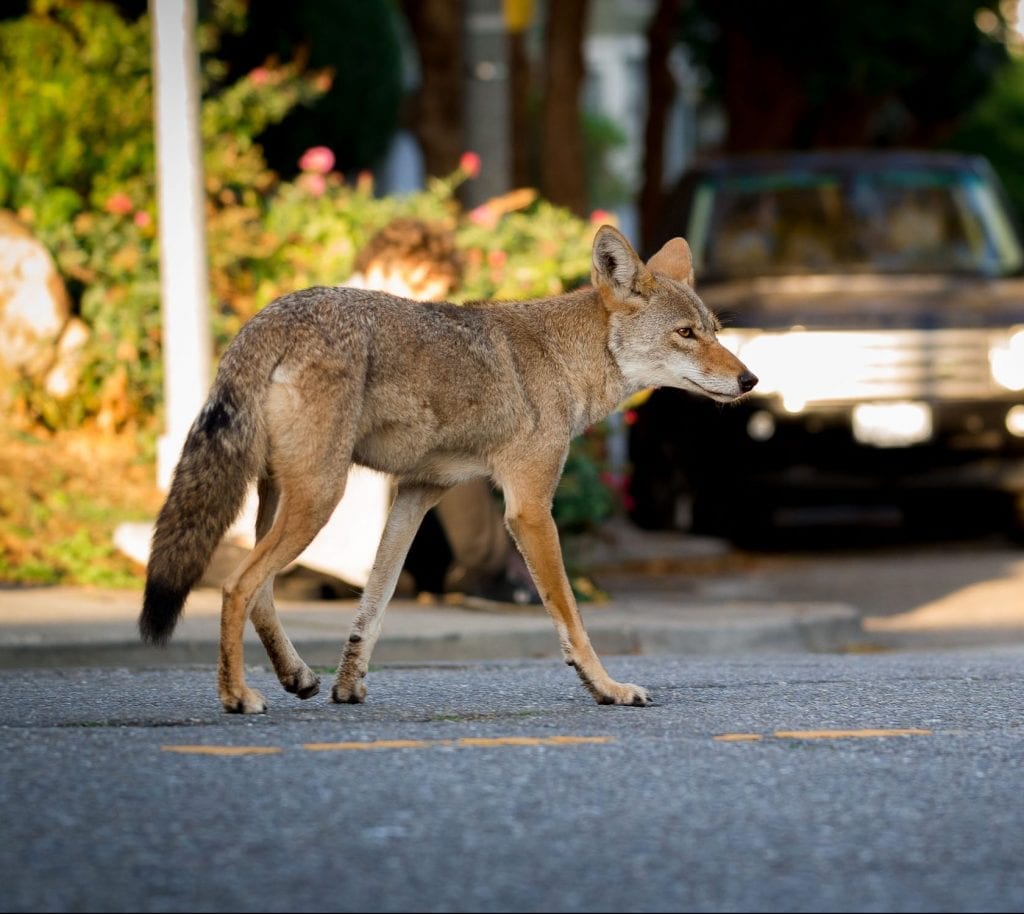
June 20, 2019 by Carol Britton Meyer
Residents have reported 103 coyote sightings through Hingham’s new reporting system since May 21, when Asst. Town Administrator Michelle Monsegur provided a progress report about proactive steps the town is taking to address concerns centering around the increasing number of coyotes that have been spotted in different parts of town. Coyote mating season was earlier this year, so young pups are around as well as adult coyotes.
“The sightings range from just seeing a coyote in the area to coyotes interacting by crossing paths with humans, dogs, or other animals,” Animal Control Officer Leslie Badger reported to the Selectmen last night during an update about efforts to help Hingham address its coyote issues. Police Chief Glenn Olsson also made a presentation. “Animal Control and police officers handled 79 calls regarding coyotes since [early January].” Ten of those reports resulted in further action by Badger.
One incident involved a toddler and coyote crossing paths in a backyard. "They did not touch," Badger said. "Her mother and aunt scared the coyote off and the child was unharmed."
Also since May 21, three incidents were reported involving coyote interactions with dogs, where the dogs were bitten. “All three owners reported that their dogs were off-leash either unsupervised or at a distance away from them,” Badger said.
With the arrival of summer, residents are cautioned to bring all leftover food items and scraps — even burned marshmallows — from barbecues or fire pits, both cooked and uncooked, inside and to also remove all food scraps that could attract coyotes.
Olsson noted that Mass Fish and Wildlife provided the town with an updated scientific study on coyote habits. “Strikingly, coyotes in the western part of the state have a territory that extends for about seven square miles, and they will travel within that radius to find food,” Selectmen Chairman Karen Johnson said.
In suburban areas, research shows, the coyote territory is about three square miles, and coyote scat analysis reveals that about one-third of the diet of these coyotes is from human sources. “It may be a bit counter-intuitive, but coyotes in the suburbs with more convenient food sources support a larger pack within a smaller radius,” Johnson noted.
Interaction with state agencies
At last night’s meeting Johnson reported that she participated in a call with Olsson, Badger, Town Administrator Tom Mayo, and a number of representatives from Mass Fish and Wildlife and the Environmental Police to brainstorm about “best practices” for addressing wildlife concerns, particularly coyotes, in suburban areas.
“State officials were extremely impressed with Leslie’s outreach and educational efforts, especially her neighborhood meetings,” Johnson said. “We are in the process of scheduling a meeting with the state to come to Hingham to walk areas with high coyote activity to see if there are steps we can take to affirmatively address these issues.”
Selectmen Joseph Fisher and Mary Power complimented Badger and Olsson for their major efforts during such a short period of time.
Power also thanked the public for helping the town gather data on coyotes by taking the time to report sightings — critical information to the town’s discussions with state officials. There were no questions from the public.
There are a number of options to help decrease interactions with and sightings of coyotes. “The best solution is to reduce the food source and to educate the public about coyote behaviors and ways to prevent them from using your space,” Badger said.
That said, town officials will continue to work with state officials and a wildlife biologist to seek other creative solutions, and whenever possible to use the topography and barriers to control movements of coyotes, Olsson said.
Options
Other options include reviewing town policies on domesticated animals such as chickens and ducks and to review trash pick-up at public, recreation, and park areas and also public permits involving food service to require that all food waste and trash be removed from the scene.
While some people advocate for hunting coyotes, some experts say that’s not the best solution in part because coyotes removed from an area will quickly be replaced by other coyotes. Research suggests that when aggressively controlled, coyotes can increase their reproductive rate by breeding at an earlier age and having larger litters, with a higher survival rate among the young, according to the Humane Society of the United States website. This allows coyote populations to bounce back quickly.
The Hingham Police Department has improved its online data collection tools. Additional information about coyotes and also an online coyote sighting form are posted on the HPD website at https://hpd.org/241/Coyotes.
Information and a coyote presentation are available on the Animal Control Officer website. Badger also summarized information from the town’s partners at the state level to combine a “Backyard Checklist” of actions residents can take to minimize coyote activity.
Message from HPD: “Please DO NOT call 911 or the police station business line to report seeing a coyote unless there is an emergency or immediate threat to humans.
The Hingham Police Department and Animal Control Officer want to have all sightings reported and logged in a central location so we can address any threats appropriately. To report a coyote sighting please complete the Report a Coyote Sighting Form and include as much detail as possible. All sightings reported via this form will be logged and followed up on by the Animal Control Officer or one of her assistants.”
The Hingham Anchor will continue to provide updates as they become available.

